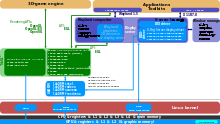Direct rendering infrastructure
The Direct Rendering Infrastructure (abbreviated DRI ) is a framework for Unix-like operating systems , which is supposed to enable the most direct, yet secure and stable access to 3D accelerators . The name comes from the fact that indirect rendering , for example via the GLX protocol, has been replaced.
Software architecture
The DRI consists of the kernel module Direct Rendering Manager (DRM), which provides an interface to the graphics card , and components in the user space that access it. The latter part of the DRI provides a hardware-accelerated back-end for Mesa and translates the application's commands into hardware-specific commands, which it sends to the graphics card via the DRM.
DRI2
Since 2007, the development of a successor version of DRI has been driven forward, which eliminates several weaknesses of DRI, especially in conjunction with AIGLX . At the beginning of 2008 the first DRI2 graphics drivers were added to the X.Org server's developer tree.
DRI3
DRI3 was released on November 1, 2013. It contains numerous changes from DRI2.
Driver support
DRI is supported by almost all free drivers in the X.Org server and in XFree86 . Some proprietary drivers such as AMD / ATI also support DRI.
history
There were only 2D drivers, and these were also part of the X server
Only indirect image synthesis via the GLX protocol was possible; there were also Utah GLX drivers
Hardware access is only via the Direct Rendering Manager possible
See also
- AIGLX , a hardware-accelerated extension of the X Window System that relies on DRI
- Xgl , another extension that uses a second, hardware-accelerated X server
- Xegl , an X server based on Mesa 3D and DRI
Web links
Individual evidence
- ^ Keith Packard: Announce: dri3proto 1.0. November 1, 2013, accessed December 4, 2013 .
- ↑ Jake Edge: DRI3 and Present. LWN, October 9, 2013.





